OK, before you all start moaning and groaning about this not being a Jeep modification, I can tell you now that you are wrong, Wrong, WRONG!
Upon returning from a friend’s place where we did a front caliper swap on his TJ’s D44 front axle, I found a package sitting on my desk.. I glanced at the shipping label and noticed it was from MikeW, a local Jeepin’ buddy that spent the week with us at Moab last month (3rd Annual Jeeps Unlimited Moab Run). The package was just the right size for a VHS tape, although I didn’t remember Mike having his camcorder along on this trip.
I opened the package with the expectations of sitting down to watch some wheelin’ footage from Moab. Boy, was I wrong. Instead of a home brew wheelin’ video, I was staring at the most unique looking flashlight I had ever seen. It is called the NightStar and is distributed in the US by Applied Innovative Technologies, Inc.
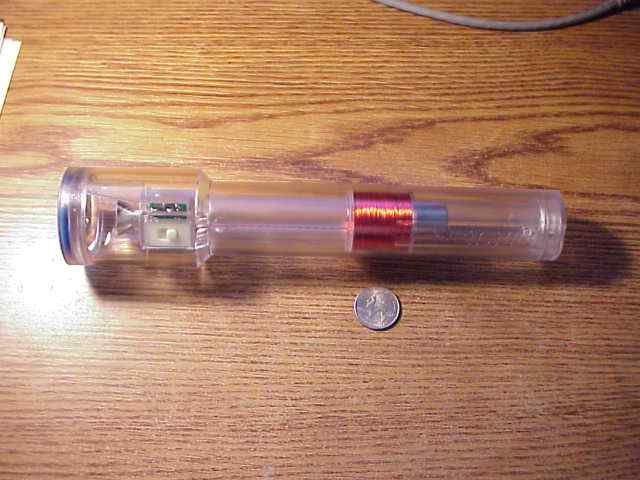
The flashlight comes in an 11 ounce, high strength, clear plastic housing. It contains no batteries, no bulbs, and the on/off switch consists of a small magnet that actuates a tiny reed relay on the inside of the housing. As such, the flashlight is waterproof to a depth of 430 feet (note that I would NOT consider this flashlight to be a useful diving light, having done some night scuba diving). It also floats so you won’t have to worry about testing its depth rating. The coin in the above picture is a US quarter.
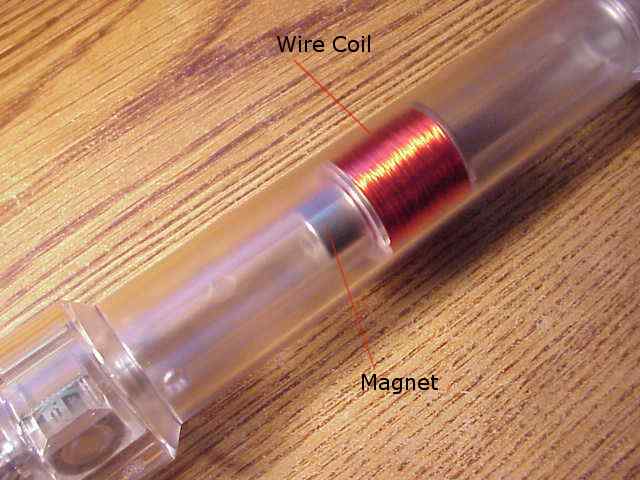
The power source for this little beauty relies on a 400 year old science experiment that proves that a magnet will induce electrical current to flow in a coil of wire when it is passes through the coil. Some of you may know this by its more common name, a generator. Now, if we can store this electrical energy for later use, we have the makings of a renewable power source and it does not rely on batteries. (OK folks, now pat yourself on the back for being environmentally friendly too!)
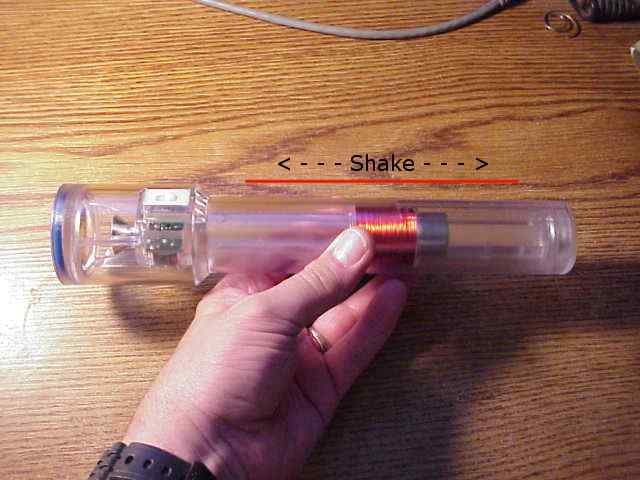
The instructions that come with the NightStar state that 20 minutes of “light” time can be created by 30 seconds of shaking motion. Simply shake the flashlight, using a side to side motion, for 30 seconds. You will find a natural rhythm of about 3 shakes per second that allows you to easily charge up the flashlight. There are two repeller magnets, one mounted in each end of the flashlight, that prevents the movable magnet from bumping into the ends of the flashlight’s plastic case. (I still think that is so cool.)
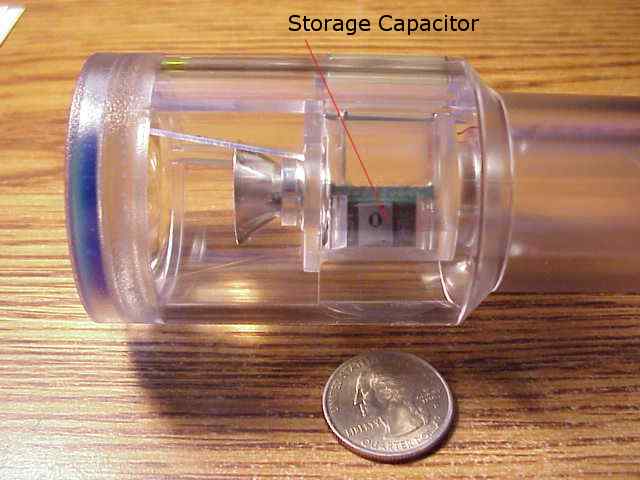 Here is a close up of the storage capacitor. It is attached to a very small electronic circuit board. The electrical leads from the wire coil attach to the board as well. It is this storage capacitor that functions similar to a regular battery, except this capacitor can be recharged thousands and thousands of times. Granted, it doesn’t last as long as a battery, but then again, when it runs out, you only have to shake the light for 30 seconds and you are good to go once again.
Here is a close up of the storage capacitor. It is attached to a very small electronic circuit board. The electrical leads from the wire coil attach to the board as well. It is this storage capacitor that functions similar to a regular battery, except this capacitor can be recharged thousands and thousands of times. Granted, it doesn’t last as long as a battery, but then again, when it runs out, you only have to shake the light for 30 seconds and you are good to go once again.
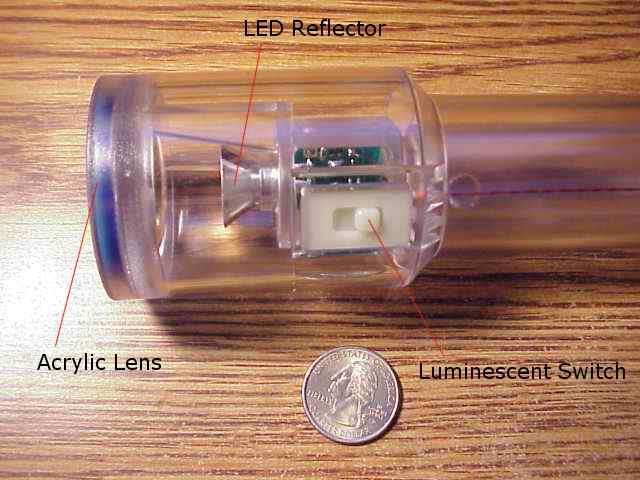
A VERY bright white LED (light emitting diode) is located in an LED reflector assembly. The LED’s light beam is further shaped by the acrylic lens which I found to be a good compromise (between a flood and spot beams) for a low power flashlight. The switch assembly is made from a luminescent material which gives it that “glow in the dark” property, making it easier to locate the flashlight inside of a dark Jeep. Of course, if you store the flashlight in a dark area, don’t expect the luminescent switch to be glowing when you go looking for it (DOH!).
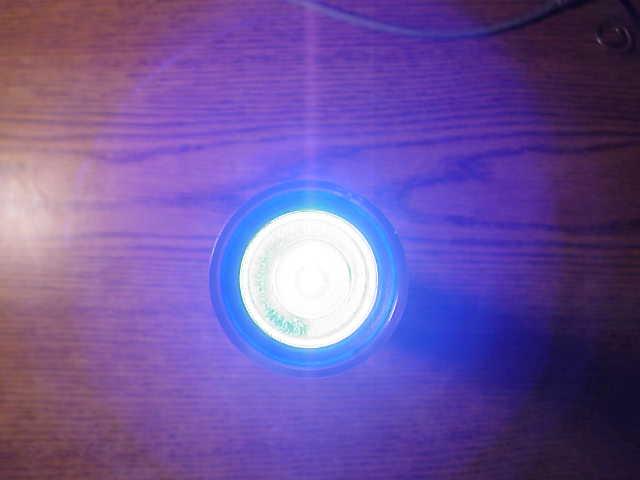
Here is the business end of the flashlight, after the requisite 30 second charging cycle. I tested the staying power of the light and it did remain functional for 20 minutes, although I must admit that things were getting quite dim during those last few minutes. However, a quick 30 second shake and it was back again to full strength…..and I can certainly live with that.
Now, you are probably wondering why I claimed this is a Jeep mod…..well, its because the small MagLite 2 cell flashlight that I currently keep in the TJ is going to get replaced by THIS flashlight…..so yes, this is a Jeep modification, heck, its even an upgrade! I look forward to NOT having the batteries either run down or leak in my TJ’s emergency flashlight. I walked around the house last night, with the lights out, just to make sure I would be comfortable using this if I really had to. I have no doubt what so ever that it will suffice for being either the primary flashlight for use during a night run’s parts replacement session or for walking along the trail at night (while you are hiking out to get the spare parts you didn’t bring along).
Update 11/06/2004:
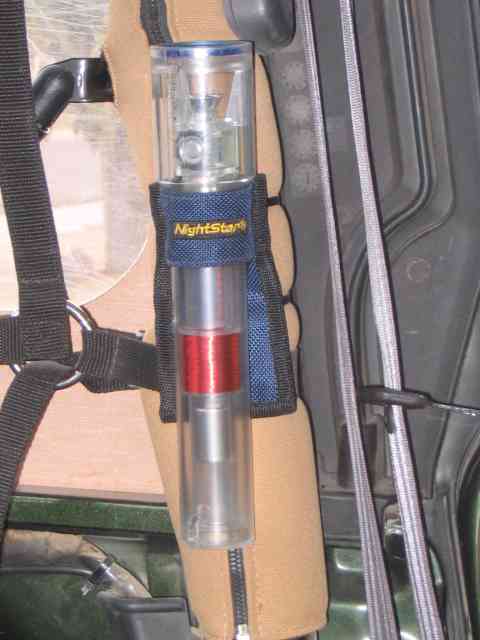
I was looking through the AIT web site and discovered a belt holster for the NightStar. While I didn’t see myself carrying it from my belt, I got to thinking about the possibilities of using it in the TJ. The flashlight has been tucked in along the seat for over a year (where it would sometimes get loose and roll out under my feet on the trail, not good). So, the holster was attached to the roll cage, next to the driver’s seat, with a couple of heavy duty zip ties. It fits nicely and doesn’t interfere with reclining the seat. I think I am going to like this new location….easy to access and ready when needed. And who knows….maybe on some of those really bumpy trails, the NightStar will charge itself!
You can order a NightStar right now, before you forget, by clicking on the NightStar graphic directly below. This is a great emergency flashlight, for home or vehicle. It comes with a 5 year guarantee. I am expecting it to last far longer than that, given the rugged design and simple power source that it employs.
I want to thank MikeW, again, for a most excellent Jeep accessory. I guess I’ll have to put together a night run and make sure Mike is along (with his NightStar) for the fun!.
NightStar CS Flashlight
(Compact Series)
They say that a good company doesn’t sit on its….well….you know….they don’t sit around once they have brought a good product to market. And it would seem that the folks at AIT haven’t been sitting around either because they just introduced another quality flashlight to their line, the NightStar CS.
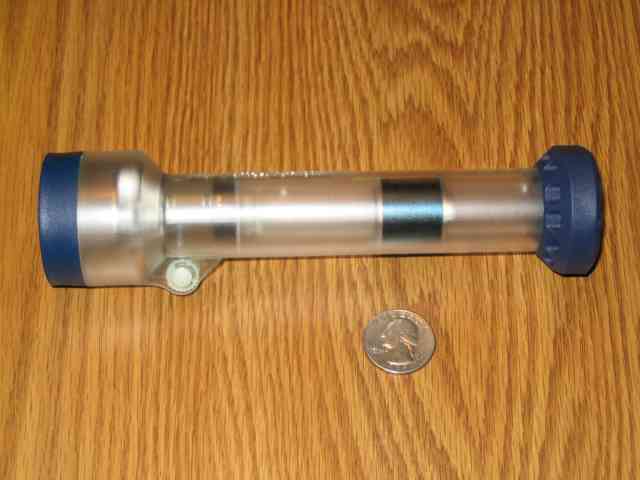
Weighing in at a mere 5.4 ounces, this 7″ long version is boldly following in its big brother’s footsteps….and I would have to say that it has no problem doing so. Like the bigger NightStar, the CS uses a magnetic power system. Due to the slightly smaller size of the CS’s generator, a full charge is achieved in 3 minutes of shaking which gives you 20+ minutes of light. In contrast, the larger magnet and charging coil on the NightStar will efficiently charge its storage capacitor in about 30 seconds. Having had the opportunity to use both models, I don’t mind the increased charge time in consideration for the smaller size. Besides, a little extra exercise never hurt anyone.

As you can see, it’s not as big as its predecessor which means you can stash this smaller model in a lot more places. It is waterproof to a depth of 160 feet and like the bigger model, it floats too. (Did I mention it floats with the shiny end pointing up?) It is made from the same heavy duty polycarbonate material used in the NightStar. Just for the record, my NightStar has been bouncing around in my Jeep for the past 16 months, tucked down along side the driver’s seat. The stuff is rugged, plain and simple. I would hesitate to subject a regular flashlight to the same conditions.
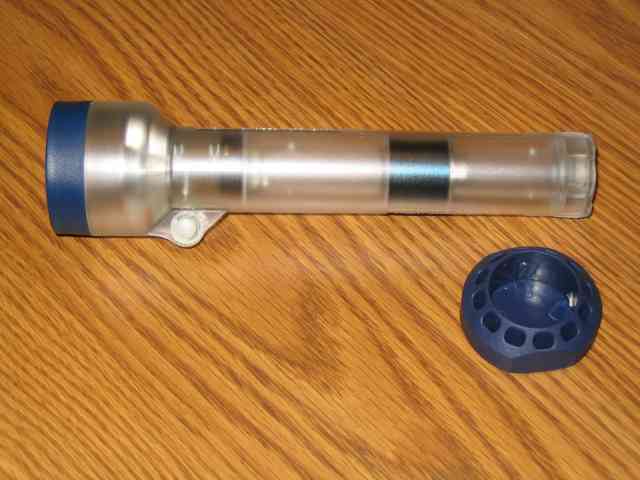
The CS has a removable lanyard attachment (base) that can be popped off. This really slims down the body of the light and makes it easier to stash it in a pocket or purse. I’ve seen some of those nylon loop holders (kind of like a holster) that are designed to hang an item from your belt. The CS should fit nicely in one of those. I think I’ll see if I can find one for the Jeep and attach it to a vertical section of the rollbar. That will keep the CS within easy reach, even during a rollover. (DOH!)
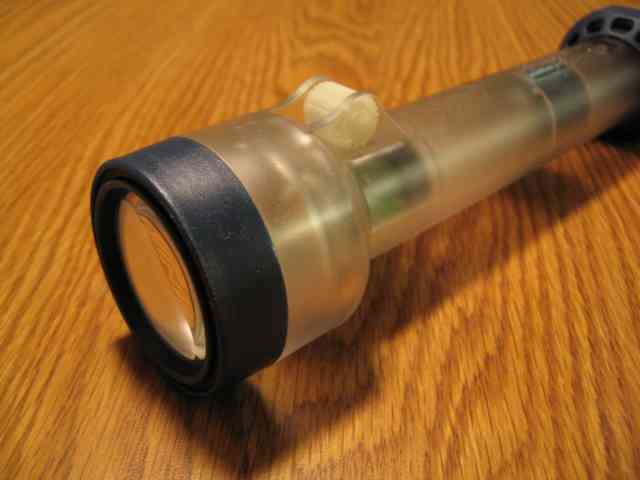
The switch on the CS is a little different from the original NightStar but it works on the same principle. When rolling this switch with your thumb, a tiny magnet rotates into position and closes the contacts on an internally mounted magnetic reed switch. By doing it in this fashion, AIT keeps the housing free of holes and leaky rubber seals. The power switch is also luminescent so it is easier to find rolling around the floorboards of your Jeep, not that I know anything about that! I checked with the folks at AIT and they verified that the internal electronics and lens used in the CS is of the same high quality as those used in the NightStar. When asked why the switch design was changed, I was told, “The reason we changed from a sliding external switch to a rotary switch was to eliminate the problem of clogging (in the NightStar, mud can get trapped in the sliding mechanism). With the CS, this problem is avoided because there�s no where for mud or debris to get trapped, and even if the mechanism gets caked with mud, the wheel will still rotate.)”
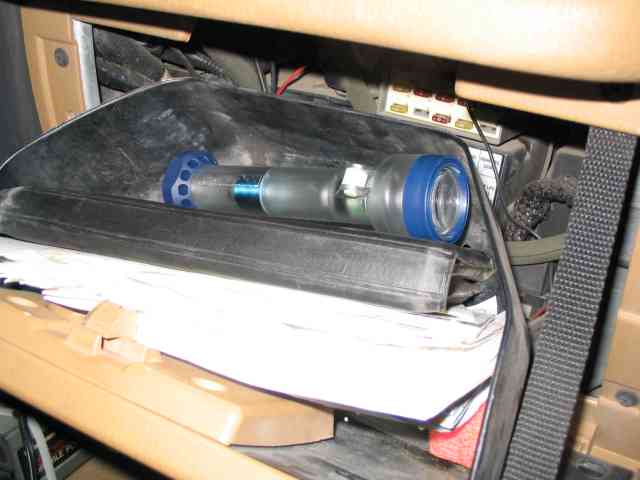
OK….so we all know that the glove box in the TJ isn’t exactly the world’s biggest (are any of them?). The CS fits nicely into the smaller dimension of the glove box, even when loaded with the usual junk mine manages to accumulate.
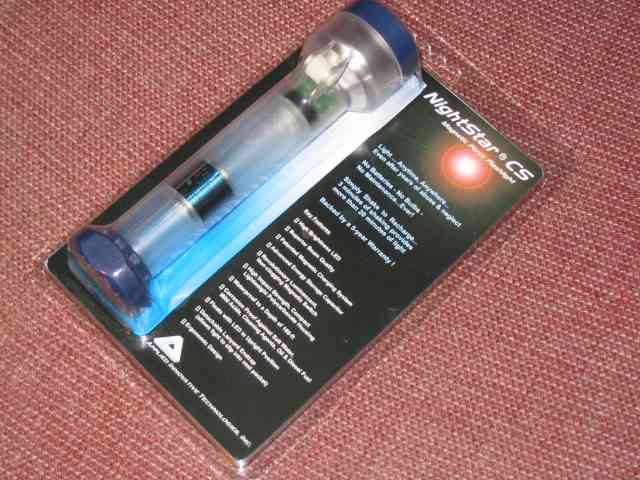
So there you got it…..a smaller sized version of the NightStar, the NightStar CS. And as though those things I mentioned above weren’t enough, I noticed that the included documentation mentions a way you can make the CS into a compass by attaching a string at the middle of the body. When you do this, the front end of the CS will point North. Yeah, try that with your energizer bunny and see what happens!
Space is always at a premium in a Jeep, you know and I know it. Not having an emergency flashlight in your vehicle is just plain careless, you know that too! The NightStar CS provides more than enough emergency lighting and it won’t suck up valuable space. Do yourself a favor and get one of these. They would make a great Christmas or birthday present. Every Jeeper needs one, including you. You can order one right now, before you forget, by clicking on the NightStar graphic directly below.
Good trails and TREADLightly! (even at night!)
Update: 10/18/2008
It’s been a few years since I’ve done this product review. I still have several NightStar flashlights located around the house and in my Jeep. All of them continue to work as expected and are just as good as the day I got them.
Some things have changed since the above review was written…..one being that my wife and I have been blessed with our first grandchild. Aidan turned one year old earlier this month. He gets into everything (literally) when he comes to visit (that would be several times a month) and grandma discovered some time back that he likes flashlights.
Well, why let him kill the batteries in a conventional light when he can use a NightStar?

So Grandpa being the good guy that he is lets Aidan borrow one of his NightStar flashlights when ever he comes over to visit. When Aidan is not using it, it sits on top of computer desk in the office. When Aidan is over, it is frequently in his hands.
You would be smiling too if you were 1 year old and had a flashlight that wanted to be shaken. In case you were wondering, it has happily survived the drops onto the hard tile floor, being used as a drum stick, and any number of other things that a 1 year old might do with a flashlight. Toddler proof? So far it is…..time will tell how it survives the long term affects of my best buddy under 36″ tall.
NightStar StarCore LED Technology
When I heard about AIT‘s last release, the NightStar CS model, I was very impressed to say the least. After I got my hands on one, I was more than impressed. They took a great product and shrunk it down in size to make it fit in places that the larger NightStar did not go.
Well, just when I think a good thing can’t get better, the folks at AIT proved me wrong. The latest change to the NightStar flashlight is their StarCore LED Technology. They aren’t saying just how they did it, but it is obvious they beefed up that ol’ LED. I’m thinking they hooked it up with a hemi or maybe even a supercharger. I’m not sure, but it is noticeably brighter than the previous model. I was also comparing the stats between this model and the first one I got…..seems that you can submerge this one down to 2200 feet. I’m thinking that is probably far enough for most folks. My diving pool is fairly deep, but not quite that deep!
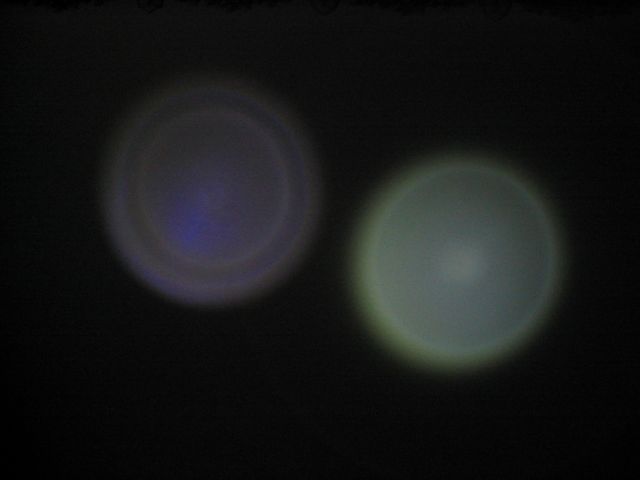
I’ll admit that I am not a test lab with sophisticated equipment that can measure lumens (light intensity) but I can say that I can see the difference between the two NightStars. In the above picture, the StarCore equipped unit is on the right. I charged both units for about 45 seconds and then shined them on the computer room wall. I turned off the flash on my digital camera and snapped a picture of the reflection of the lights. The folks at AIT say the new model is 2.5 times brighter than the old LED. I can’t tell you it is or isn’t 2.5 times brighter, but I can sure tell the difference in a dark room with both of them in hand. This model is pushing into the arena previously reserved for the regular incandescent bulb flashlights.
Next, I tried a much more scientific approach to determining which was brighter. Again, with both unit fully charged, I stared directly into each light for several seconds. Yep, I had to squint more or risk the chance of going blind when I looked into the StarCore model. (OK….so I probably wouldn’t have gone blind but it was still brighter.) Kids, do not try this at home….take my word for it! (so you don’t get yelled at by your parents)
My last test involved turning the lights off in the house and comparing the light beams in a real world situation….shining them down the hall way, lighting up the living room, looking for the dog’s tennis ball under the master bed, you know, the kind of stuff you really do use a flashlight for. There is no doubt that the new model performed better. It was brighter by a pretty fair amount.
I wanted to comment on one more thing which has nothing to do with how bright the LED is but rather speaks to the quality of the flashlight itself. The first NightStar I had was relegated to Jeep duty, on the floor by the driver’s seat, for about a year. After that, it was elevated (literally) to the roll bar where it has stayed in its cool holster. As I was checking out the new light, I compared its lens to the first model that has been bouncing around in my Jeep. I could not tell the difference between the two lenses. The lens on my older model looked as scratch free as the new StarCore model. I’m not claiming that the lens is scratchproof, but I am very impressed that it held up to the rigors of under the seat Jeep life and came out looking good as new. It says a lot for the material used in the flashlight.
Well, that is about it for now. I’m moving the StarCore model into the Jeep holster….and…..my wife’s car will get the older one. She’s not nearly in the dark as much as I usually am. <grin>
Ready Welder II
You are on the level 5 trail….it’s been 4 hard hours of wheelin’ since you put the t-case in 4LO. There is about an hour of trail left (if all goes well) with a nasty rock garden right at the end. The speaker on the CB crackles and you hear your buddy’s voice. “I got a problem….I ripped a control arm bracket off.”
Sound familiar? If it doesn’t, then you simply haven’t been on enough trails yet because it will happen. And if it isn’t a control arm bracket, it will be the track bar bracket or something else. This actually happened earlier this year on Die Hard. BobP ripped a control arm bracket off the frame on a bad section of the trail. BobP had his welder with him and in about an hour, he was back in action finishing the trail.
This past spring (2006) at the 6th Annual Jeeps Unlimited Moab Run, we had two suspension failures during the week, a rear upper frame end control arm bracket and a front axle lower control arm bracket. They ripped off of the frame and axle tube, respectively. On both occasions, someone in the group had a welder along to do the repairs. It wasn’t production quality welding, but it was good enough to hold the suspension together and make it off the trail.

The Ready Welder II (RWII) was introduced some years back and has certainly found a home in the off-road community. It is a compact unit (packaged in a padded plastic carry case) that comes with everything you need to weld except a helmet and a power source….it even includes a roll of .035″ mild steel flux-core wire. The most common power source is a pair of 12V vehicle batteries connected in series for 24 volt MIG welding, which yields up to 275 amps. This 100% duty cycle welder is capable of operating on DC power ranging from 18 to 40 volts, so a third 12V battery can be added in series to provide 36 volts at up to 400 amps of welding current. More than enough to properly implement a trail side repair.
It also works quite well for the weekend project in the garage. I helped ScottK do his 8.8 axle swap and he used a Ready Welder II for it…..that was several years ago. I was totally impressed with the results. He had a pair of 12V deep cycle batteries he kept on a roll around cart (with a pair of inexpensive chargers). Doing the welding commonly found on a weekend Jeep project, Scott had no problem with the batteries lasting all day. I don’t recall a time when he ran out of battery before running out of project. Note: The above mentioned repair on BobP’s TJ was done with ScottK’s RWII, which now belongs to BobP, as does ScottK’s old TJ.
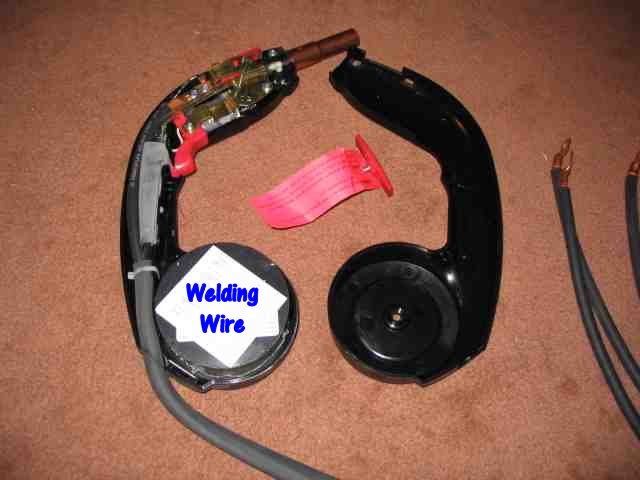
The business end of the RWII is shown above with the cover removed. A 1pound spool of wire resides in the handle (left hand side of photo) and makes for a fairly handy setup although sometimes you may find it a little awkward when attempting to weld in a very tight space. None the less, it does work quite well. Wire size from .023 to .045 can be used without any modifications to the feed mechanism. Screw in replacement tips can be purchased in bulk (25 to a pack) for less than $25.

The controls are pretty basic. The trigger turns on the wire feed motor and the red dial is used to control the wire feed speed. A pair of LEDs (one green, one red) indicate the polarity of the gun (details included the RWII manual). The trigger does NOT control the tip….it is always electrically hot (on this model), so be careful that you don’t arc it while moving the tip into position. Ready Welder has recently released a “cool” tip model which eliminates the always hot tip.

The RWII comes with a jumper cable with copper terminals already crimped onto each end. The jumper cable is used to series a pair of batteries together to obtain 24 volts. If the batteries are equipped with stud terminals, the jump cable can be attached directly to the studs. If not, the supplied battery clamps can be attached to the cable and used in that fashion.
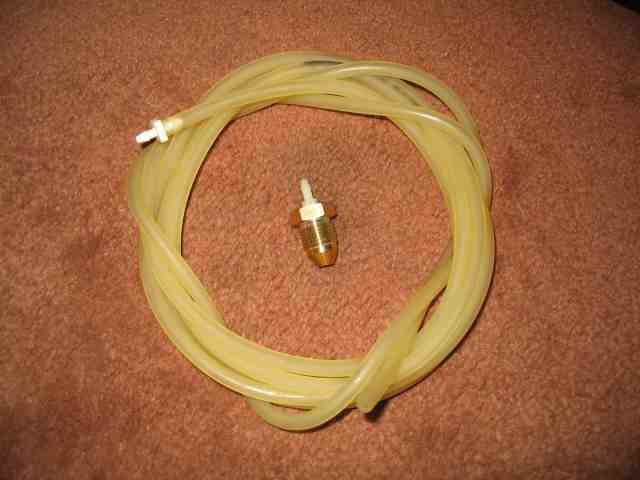
The RWII can be used with a shielding gas if so desired. An extra 10′ of hose is supplied for connection to your tank. For those folks that carry a CO2 bottle on the trail, it would probably we worth getting a low pressure adjustable regulator to use with the RWII.
Ready Welder II
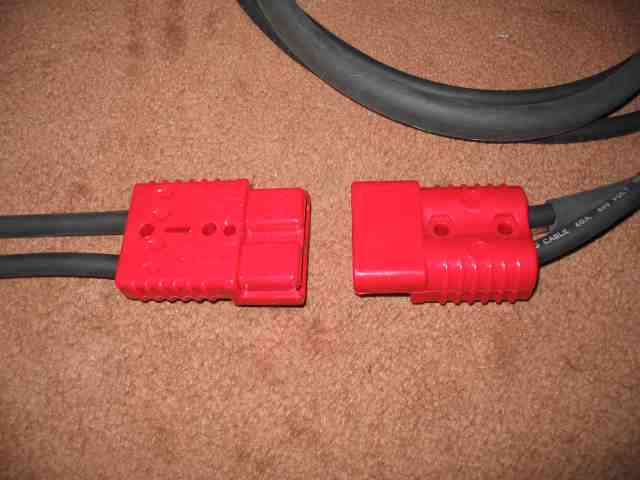
The RWII comes with a 2′ long set of battery cables that terminate in a quick disconnect. The RWII power cable is 10′ long and has a mating connector to plug into the battery cable. This allows you easily down power the RWII and not worry about the hot tip between welding sessions. This also allows for Ready Welder available extension cables. A friend of mine as a 20′ extension cable which allows him to weld up to 30′ from the power source.
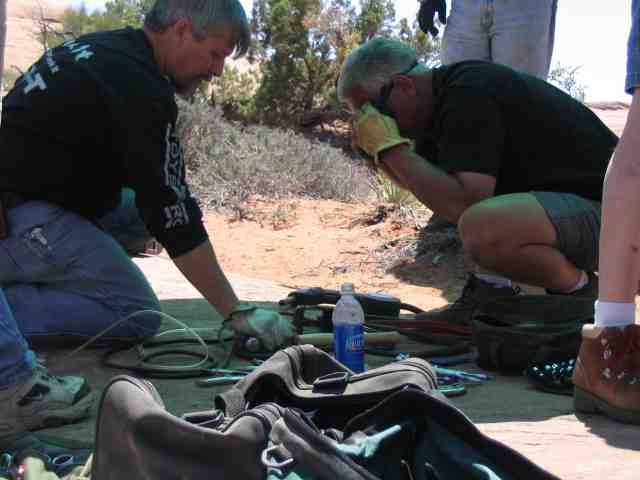
A trail side photo of LarryN and myself during one of the 6AJUMR welding sessions. With plenty of helping hands, we had a green tarp being held above us for shade while we worked on the broken control arm mount. There isn’t much in the way of shade in Moab and even though we were there in early May, the mid-afternoon sun warmed things up pretty good.

With a slightly green tint from the tarp, you can see the welding that LarryN did on the bracket (before it was welded back onto the axle tube). More than good enough to get you off the trail and back to the shop where some extra reinforcing can be done.
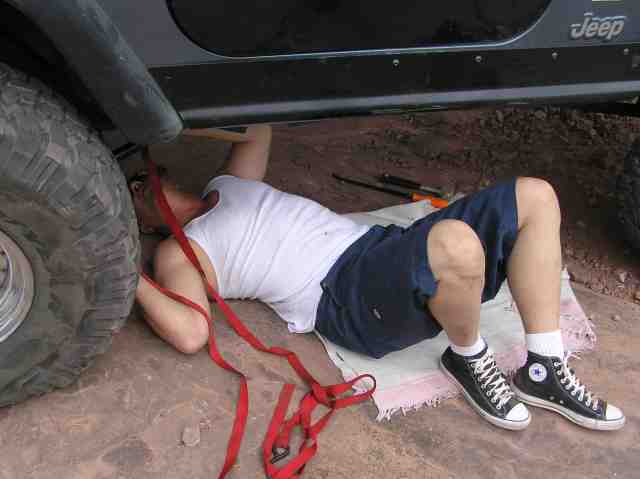
Here is a pic of RobertY getting ready to weld on Trina’s TJ. We were at the top of the Z-turn, coming down, when she realized her control arm mount was broken. Notice the ratchet straps….a very handy item to have with you. When you weld the mount back on, it is rarely in the correct position due to the axle being shifted a small amount (because the arm is already broken). Several ratchet straps are handy as they can be used to pull the axle into position and thus get the bracket back into the correct location for welding. A couple other suggestions…..carry a heavy denim jacket for welding….it will help keep the sparks from hurting as much as you lay on your back (watching them fall on you).
Upon my return from this year’s Moab run, I talked to a friend of mine about the RWII. He had one that he wasn’t using and although it was “used”, the plastic wrapper on the spool of wire had yet to be removed. I picked it up for a reasonable price and claimed it as mine.
Don’t forget some kind of welding protection for you eyes. Due to space limitations, RobertY carriers a sock hood, which is essentially a leather hood that fits over your head and has a shaded welding lens built into it. The benefit of this is that it can be folded up and stored into a fairly small space when compared to a standard welding mask. It is hot (as Robert found out), but it will get the job done and that is what it is all about. Another suggestion is to carry a couple of small pieces of metal that could be used to patch a broken “something” on your TJ. Some various shapes and thicknesses will help you find the right piece for the trail fix should the need arise.
That about wraps up my comments on the Ready Welder II. It’s probably one of those higher end “mods” that most folks won’t get, and certainly not everyone on the trail needs one. But you will be a lot better off if someone in your group has one with them AND someone in the group knows how to use it.
Something that many folks don’t remember…..the first TJs made are now almost 10 years old (as I write this). Even if these vehicles are not subjected to tough rock crawling trails, such as Die Hard, just pushing 33″ tires around on 3.0 trails will take its toll on the brackets. If you are running stock brackets, then it is not a matter of IF your bracket breaks, it is only a matter of when it breaks….the metal can not take all that stress and still last for ever.
Think about it….the RWII is a worthwhile investment, in my opinion. If I didn’t think so, I wouldn’t have spent the money for one.
Good trails to you and remember to TREADLightly!
